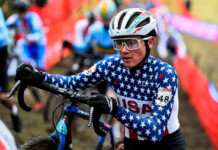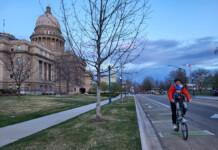By Charles Pekow
 Crash reports from the United States don’t show that roundabouts have been particularly hazardous for bicyclists. Advantages include the fact that motorists tend to slow down in circles and cyclists don’t turn as sharply.
Crash reports from the United States don’t show that roundabouts have been particularly hazardous for bicyclists. Advantages include the fact that motorists tend to slow down in circles and cyclists don’t turn as sharply.
Still, since they are becoming increasingly popular across the USA and have long been common in many cities, it’s worth paying attention to the specific issues bicyclists encounter when riding through them, says a report from the National Cooperative Highway Research Program.
The more lanes in a circle, the more confusing and more risky for cyclists. The report, Roundabouts: An Informational Guide, says that motorists are less likely to cut off cyclists in one-lane circles. The program recommends designs with multi-turn lanes for getting on or off a roundabout from a major arterial but only one turn lane when getting in or out of a minor road at the same location.
The report does not recommend bike lanes “on the circulatory roadway.” If a bike lane exists on a road, it should be ended before reaching the circle so that cyclists and autos will merge into the same lane when entering. The circle should also include ramps so cyclists have the option of using the sidewalk if they don’t feel comfortable riding in the roundabout – but this shouldn’t be necessary at single-lane roundabouts.
Developers have been installing roundabouts more frequently lately in suburban residential districts and these tend to be friendly for bicyclists. Ones in cities tend to be more complicated as they get not only a greater volume, but greater mix of traffic (buses, more trucks).
And drivers may need education about roundabouts. “While states have made tremendous progress with implementing instructions for roundabouts into their driver’s manuals, many states do not provide sufficient information for teaching a driver about using turn signals and making decisions with pedestrians, bicycles, and emergency vehicles. The Kansas Driver’s Manual, however, does provide detailed steps of navigating a roundabout and considering all users and vehicle types,” says the guide.
And it cites Bend, OR for a program that teaches children how to bike and walk through roundabouts. It says the “city’s intent was to establish the knowledge at an early age with the hope that children would already understand this type of intersection when they reached the driving age and would also be able to share the valuable knowledge with their parents.”
Find the report at https://bit.ly/2UG3Fne .
Reference: Rodegerdts, Lee August. “Roundabouts: An informational guide.” Vol. 672. Transportation Research Board, 2010.








